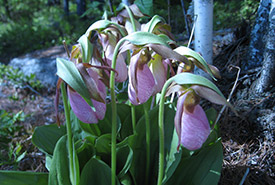Covey Hill - A symbol of our natural heritage

Pink lady's-slipper, Covey Hill (Photo by NCC)
Sitting on the Canada-U.S. border, Covey Hill is the northernmost extension of the Adirondack Mountains and rises up more than 340 metres over the Châteauguay Valley. It straddles two municipal territories of the MRC du Haut-Saint-Laurent — Havelock and Franklin — and extends all the way into New York state. This area is a true natural jewel, complete with idyllic landscapes, clear streams, beautiful woods and charming orchards and vineyards.
Covey Hill offers refuge for many rare plants and animals, including wide-ranging mammals such as bobcat, fisher and black bear.
It also provides habitat for the widest variety of salamanders in Quebec. About 10 different species of salamander are found here, including the Allegheny mountain dusky salamander. This species of stream salamander is only found in two places in Canada: Covey Hill in Montérégie and near the Niagara Escarpment in Ontario.
Video produced by Earth Rangers, NCC's partner for the protection of salamanders in Covey Hill.
Distinct features
Covey Hill is home to one of the Montérégie’s rare surviving unfragmented forests. The forest cover preserves ground humidity, protects streams from the sun and keeps the water temperature from rising. In addition, leaves and branches accumulated on the forest floor filter rainwater while minimizing erosion and sedimentation that might otherwise affect the streams inhabited by salamanders. There is also a peatland area that stores rainwater within layers of sphagnum moss that has grown over millennia. The latter acts as a sort of sponge that slowly releases water into the hill soil and maintains the flow of streams during dry periods.
One of the unique characteristics of Covey Hill is the peat bog found at the top, which stretches over roughly 55 hectares (135 acres). The bog stores rainwater in layers of sphagnum moss that have built up over nearly 15,000 years. In this way, it helps maintain the flow of streams during dry periods and influences the water cycle throughout the Châteauguay River watershed.
Covey Hill is also an important recharge area for the regional aquifer. The aquifer is the geological formation enclosing the underground water table, and the recharge is the quantity of water that infiltrates areas where the rock is exposed at the surface and where the ground is permeable.
This ecosystem has tremendous ecological importance for both wildlife and human communities. Several municipalities in the region depend on this particular groundwater supply for their drinking water.
Maintaining a rich biodiversity
Several non-intensive farming activities take place on Covey Hill. The Nature Conservancy of Canada (NCC) supports landowners who want to help protect this exceptional ecosystem through the sound management of the woods and streams on their property.
Through conservation agreements, donations and the sale of property to NCC, several families have already helped protect 526 hectares (1,300 acres) on Covey Hill for the benefit of their children and grandchildren.




